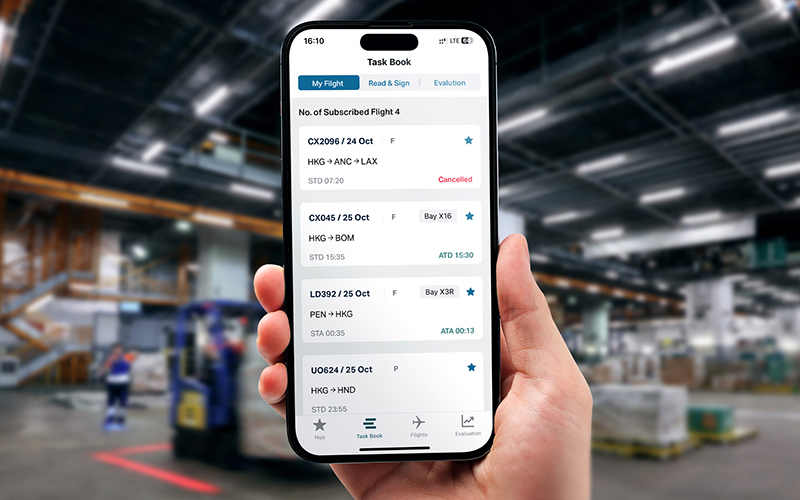For all the digitalisation in air cargo – and there is lot happening – the actual building, handling and loading of shipments remains a manual process in the warehouse and on the ramp even with the mechanical assistance of elevators, forklifts, dollies and tugs. But now Cathay Cargo is putting digitalisation into the hands of the frontline teams who oversee the shipments in their care.
Operational teams in Cathay’s Cargo Operation Centre (COC) at the Cathay Cargo Terminal are getting to grips with a new mobile app that enables them to work quicker and more efficiently while reducing their time spent on admin. And with much of the shipment audit now handled digitally, that means getting rid of even more paper from the business.
The app is called Cargo Connect, the name chosen by the frontline staff who are using it, and it’s designed to simplify and speed up the working day, as project owner Calvin Hui, Head of Cargo Operations, Hong Kong and the GBA (Greater Bay Area), explains. ‘Cargo Connect is an initiative to improve the operational efficiency and employee experience for our cargo operation teams by deploying digitalisation,’ he says.
The ultimate aim of Cargo Connect as it develops across iterations is to centralise all the tasks and information the team needs for work on any given day, whether people are in the office using a desktop computer or out on the ramp or in the warehouse using a mobile device.
‘It will provide a common digital platform for a mobile workforce with the relevant digital information,’ says Hui. ‘This is so they can deliver a reliable and high-quality service that is meaningful to the operation and our customers.’
Rather than launch with full functionality from the off, there will be continual phased development with each iteration adding more functionality, as Andress Lam, Cargo Digital Manager Transformation, explains. ‘Like many of our other undertakings where we are building the app in-house, this is an “agile” project,’ she says. This means that changes according to user feedback or requirements can be built into different launches, and after the initial roll out in Hong Kong that app will go on to standardise procedures across the global network.
For now, the app can be used for displaying the assigning duties and rosters to individual team members, while they can view stored information such as flight schedules and access resources they need in one place, without the need to go back to the office to find and download relevant materials and policies, for example.

Another big design feature is that it enables two-way communication, with shift leaders able to send push notifications to individual users about aircraft delays and changes to shift duties. ‘Briefing notes are collated from multiple sources, and briefings were conducted verbally for each shift,’ says Hui. ‘This was inefficient and difficult to manage; it’s hard to track the information shared in the first instance. And if things do change during a shift, relying on outdated information or using up time to get hold of changes could cause delays that lead to dips in on-time performance.’

The two-way communication extends to colleagues being able recognise each other for work well done, or for managers to evaluate their team’s performance. Additionally, it digitises the checklists used on the ramp, and it also removes the need to file paperwork from each flight as the information is within the system, cutting down on admin time.
‘We are hoping to remove the pigeon holes and filing cabinets from the COC office by the end of next year,’ adds Hui. ‘And the reduction in paperwork, which will contribute to our overall sustainability effort, also means that information we may need in the event of audit about a particular shipment is already on the system and does not need to dug out from paper files.’
Additionally, using the camera on their devices within the app means that any pictures that Ramp Coordinators take of the shipment and its loading are immediately saved onto the system rather than having to be downloaded and reuploaded onto another system back in the office.
The project will ultimately roll out to all operational teams worldwide including GHAs and contractors, but the developmental approach will be phased both in its capabilities and functionality from launch and the user audience.
‘In 2024, we will merge the functionality of an existing ramp tool and merge it into Cargo Connect and we will take the opportunity to streamline more ramp-related functions,’ says Lam. ‘Going forward, more features will be provided to streamline cargo operations, digitise checklists, and the product will be extended to other regions beyond Hong Kong.’
For Hui and his team, Cargo Connect is an intuitive and verifiable way to ensure that Cathay Cargo’s service can be delivered as promised, with the data retained and accessible as promised.
‘It’s an exciting time,’ he says. ‘The technology is all in place now in terms of security, in terms of cloud storage for information, plus people accept the idea of using an app. Five years ago, only half of our people would want to use an app, but it’s become second nature and intuitive to use them. We’re ready and there’s exciting developments to come.’








